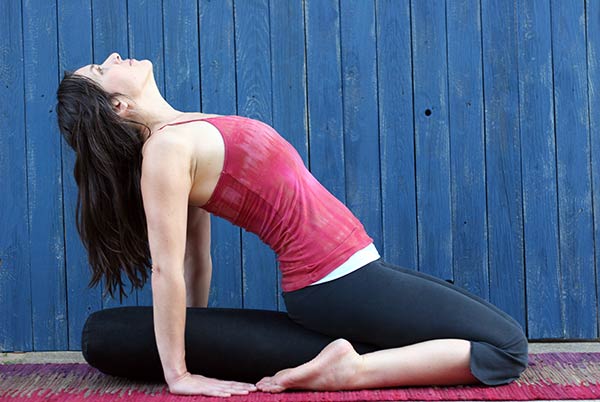
Yoga For Healthy Digestion
For those of us in this world that deal with gluten or other food allergies, sensitivities, and intolerances we are all too familiar with that “tell-tale” rumbling in our bellies. For some it starts with a cramping sensation, a sudden burst of nausea, or stabbing pain. Then, just like that moment when you get to the very top of a roller coaster seconds before the inevitable drop, we think, “Oh boy, here we go!” You know what I’m talking about! These symptoms can plague us for days, weeks, and sometimes even months, ranging from moderately irritating to downright debilitating. And oftentimes, all because of a little crumb the size of a mustard seed.
Nearly 30-40% of the world’s population suffers from irritable bowel syndrome and other digestive issues. And while gluten definitely plays its “villain” role in this, stress is another big contributing factor. I like to think of stress as gluten’s “evil side kick” because of how it can prolong or even create a vicious cycle of pain, discomfort, and unrest.
Digestion is controlled by what is called the enteric nervous system. This system is made up of hundreds of millions of nerves that communicate with the central nervous system. When stress activates the “fight or flight” response in your central nervous system, your brain automatically reduces the blood flow and temporarily shuts down your digestive function in attempt to send all of your energy and focus to your limbs and senses. While this is great if you are being chased by a giant bear or running from actual evil villains, in normal, everyday life it can have some drawbacks: things like esophagus spasms, increased acid production, decreased digestive secretions, and more. These are all normal responses, but for someone who is not in survival mode, these just translate into indigestion, stomach cramping, nausea, diarrhea and/or constipation, and even increased risk for infections. With all of that going on, it’s not hard at all to see how stress can also aggravate other diseases and conditions such as celiac disease, ulcers, inflammatory bowel disease, and a host of other digestive issues.
But don’t worry. There is a way to handle that dirty little villain called stress: It’s yoga!
Yoga is an effective way to reduce stress through calming the central nervous system. Many of the poses have been found to sooth digestive function as well. So for stressed out folks with food sensitivities, it’s a win-win! Yoga does wonders for supporting our fight against the many villains that we face in our lives, especially the digestive ones.
What follows is a practice with seven poses that support healthy digestive function in several different ways, from relieving abdominal discomfort and diarrhea/ constipation to stimulating the digestive tract and increasing abdominal blood flow.
A few tips on approaching your practice: It is important to first pay attention to your breathing habits. Stress causes our body to become hard and rigid, ready to fight or run. For this reason, you must learn how to soften the body in preparation for yoga practice. Focus on breathing into the back of your body and softening the belly. This will help you reap the full benefits of your practice and encourage your body to respond more receptive to this sequence. Hold each pose for only as long as is comfortable, stopping if it becomes difficult to breathe. You can work your way up to longer holds over time.
Most importantly, listen to your body and try to let go of any tension and hardness in your muscles. Instead, find “softness” through your breath. And don’t be surprised when you find yourself taking what you’ve learned on the mat into your everyday life.
Reclining Bound Angle (Supta Baddha Konasana)
Place a bolster directly behind you. Sit in front of it with bent knees and tailbone touching the edge of it. Bring the soles of your feet together, letting your knees fall to the sides. Lie back, allowing your head and torso to rest on the bolster with your buttocks and legs on the floor. If you feel any strain in your neck or back, place extra support under them to relieve tension. Rest in the pose for as long as it feels good. To come out of the pose, bring the knees upright and roll to the side, using your hands to help you return to a seated position.
Modifications:
• If there is straining in the neck and shoulders, place extra support under the neck.
• Reduce leg tension/strain by placing a block or rolled blanket under each thigh.
Benefits: Relieves abdominal cramping, indigestion, and diarrhea and takes pressure off of the stomach and liver. Relieves anxiety.
*Always use extra support if back injuries are present.*
Bound Angle (Baddha Konasana)
Sit against the wall with your back straight and your knees bent in front of you. Let your knees open toward the floor, then bring the soles of your feet together.Clasp the feet with your hands (or grab your toes as seen in the picture) and draw your heels as close as you comfortably can to your body. Lengthen your spine upward, leading with the crown of your head. At the same time, lengthen and gently stretch the inner thigh. Lift the abdomen upward and hold for 5-10 breaths.
Modifications:If there is tension in the hips, raise the hips up on a folded blanket.
Variations:(as seen in photo) Lean forward from the hips with an elongated spine, bending the elbows as needed to go deeper.
Benefits:Increases abdominal circulation and improves digestive function.
Hero Supported Backbend (Virasana)

Start in Hero’s pose by kneeling on the floor with a bolster or yoga blocks under your hips and your thighs close together. Allow your feet to be just slightly wider than your hips but still close enough for the inside of the heels to touch the hips. The tops of your feet should be flat on the floor and pressing down gently. Carefully lean back placing your hands directly under your shoulders with your fingers pointing forward towards your feet. Begin to arch your back, starting at the tailbone and gently moving upward through each vertebra. Create a soft arch with the spine allowing the head to fall backwards just slightly, finishing the curve. To come out of the pose, on the inhale, lengthen the spine and move to an upright position leading with the heart.
Contraindications: Do not practice this pose if you have uncontrolled high or low blood pressure or serious low back or neck injuries.
Modifications: If there is any strain in the feet, place a rolled towel under each ankle.
Benefits: Relieves abdominal cramping, indigestion, and diarrhea. Increases abdominal circulation and supports digestion.
Hero Twist
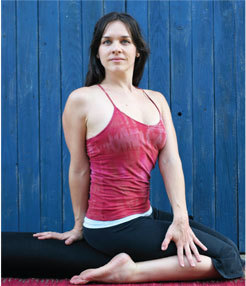
Start in hero’s pose just as you did in the last pose with a bolster or block just under your hips. Remember to keep your thighs close together. Place your right hand behind you near the right buttock and tailbone. Cross your left hand over placing your palm on the outside of your right thigh. Inhale while lengthening the spine up through the crown of the head, pressing your right/back hand into the bolster to help lift and stretch your spine more efficiently. On the exhale, twist to the right drawing your abdomen in and lifting your ribs and waist away from your hips. Draw your right shoulder blade gently toward the spine. Use the exhale to move into the twist, not forcing it with the position of your hands. Focus on breathing into the area around your heart while remaining soft in the neck and shoulders. Continue to lift the ribs gently away from the hips to maintain good extension throughout the entirety of the pose. To come out of the pose, first inhale and lengthen the spine. On the exhale, slowly reverse the twist starting with the head and shoulders, moving down to the ribs and waist, and finally ending with the abdomen facing forward. Repeat this pose on the opposite side.
Contraindications:Do not practice this pose if you are suffering from high or low blood pressure or diarrhea.
Modifications: If there is any strain in the feet, place a rolled towel under each ankle.
Benefits: Stimulates and tones abdominal organs and supports digestion and elimination of toxins from the body.
Lying Release
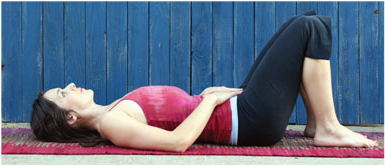
Lie on the floor with knees hip-width apart and feet a comfortable distance from your buttocks . If desired, let the knees fall together by turning the heels slightly outward. Place your hands on your abdomen with your thumbs near your navel. Do not flatten the back but instead just relax and allow it to maintain its natural curve. Draw your attention to your breath, allowing it to move down into the abdomen without strain. Focus on breathing into the back of your body, softening and relaxing the layers of abdominal muscle and creating a soft belly. Stay this way for as long as is comfortable or at least 10 breaths.,/p>
Modifications: If there is tightness in the back, place a folded blanket under the hips.
Benefits: Relieves tension in the abdomen and reduces anxiety by calming the nervous system.
Pranayama
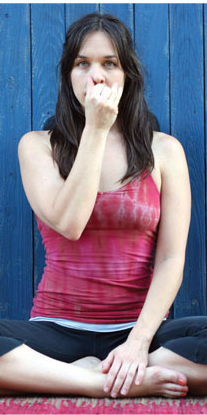
Sit in a comfortable position with legs crossed and back resting against the wall. Focus on using your breath to create softness in the body throughout the exercise. Using your right hand, bring your thumb to the right side of your nose and your ring finger to the left side. Close off your right nostril with your thumb. Inhale through your left nostril. Close off your left nostril with your ring finger then open and exhale through your right nostril.Next inhale through your right nostril, then close the right nostril with your thumb and open and exhale through your left nostril. Continue alternating 5 to 10 times.
Contraindications: Do not practice if you have low blood pressure.
Benefits: Improves digestion and strengthens the immune system. Reduces stress and depression.
Apanasana
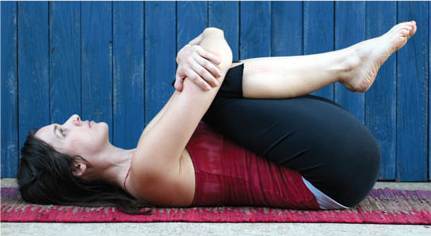
Begin in Lying Release pose as previously described with knees bent and hip-width apart. On the inhale, lengthen the spine, again breathing into the back of the body. On the exhale, draw the knees in towards the chest with thighs resting against the belly. Hold the knees with your hands or clasp the wrists (or elbows for a deeper release) focusing on the softness of the belly as you breathe. Keep the neck and shoulders relaxed. Hold for 5 to 8 breaths. If desired, return to Lying Release for as long as you like to complete your practice.
Contraindications: Do not practice this pose if you are experiencing diarrhea.
Benefits: Massages and stimulates the lower digestive tract. Relieves constipation
Written by Jenni Hulet founder of www.theurbanposer.com



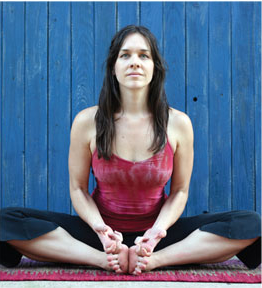

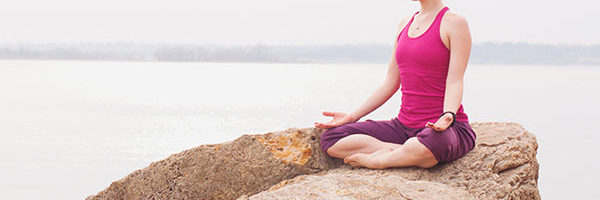
Very innovative
Thanks a lot